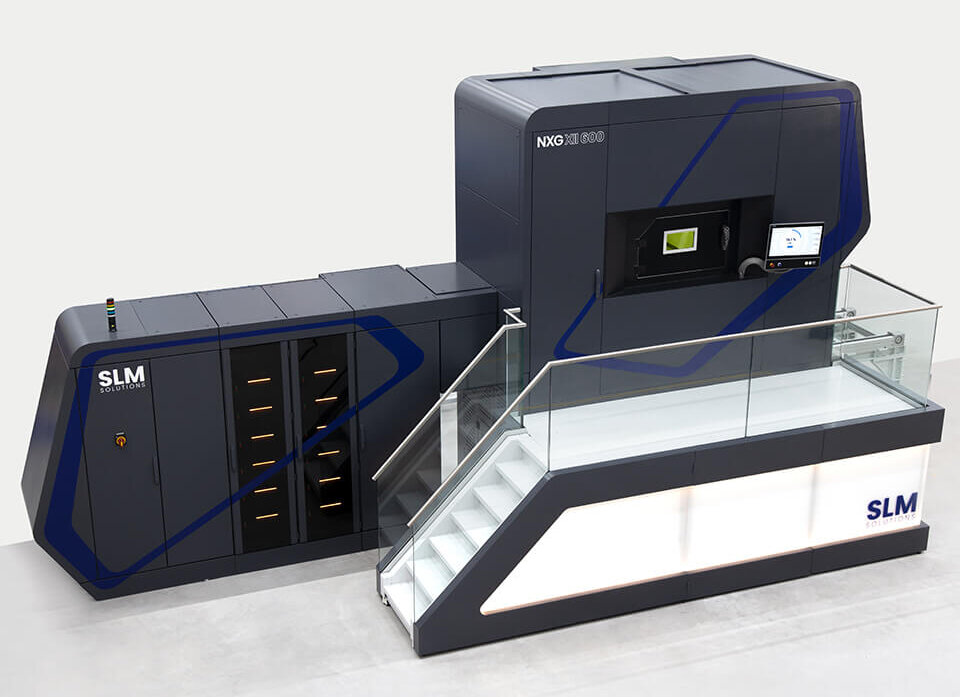After already boasting one of the world’s most advanced, largest, and productive powder bed metal 3D printers, SLM Solutions has been enlisted to make something even bigger. Thanks to a $5.2 million contract from the U.S. Air Force Research Laboratory (AFRL), Concurrent Technologies Corporation (CTC) will be working with subcontractor SLM Solutions to build “the world’s largest additive manufacturing (AM) machine.”
The NXG XII 600 E Metal 3D Printer
In order to address the U.S. military’s desire for 3D printing longer parts, CTC has chosen the U.S. office of SLM Solutions NA to develop a metal 3D printer with a z-axis of 1.5 meters. The new system would expand on SLM’s existing NXG XII, a 12-laser laser PBF 3D printer used by such companies as Divergent Technologies to 3D print metal auto parts. That machine has a build volume of 600 x 600 x 600. The new the NXG XII 600 E will feature the same “lightning-fast speed and productivity” as its predecessor, but with an extended, 1500 mm Z-axis.
“We are excited to play a role in this ground-breaking AM advancement,” said Edward J. Sheehan, Jr., CTC President and CEO. “The technical work we are performing for this project includes elements of CTC’s full-service portfolio of AM capabilities including design, testing, post processing, machining, and qualification.”
While the phrasing “the world’s largest additive manufacturing machine” may not be strictly accurate when applied to 3D printers generally, it could make sense if we compare the planned system to other PBF machines. Firms like Sciaky, COBOD, voxeljet, and Ingersoll produce among the largest 3D printers for metal deposition, concrete, (non-concrete) ceramics, and polymers, respectively. In fact, in the past, CTC has worked with Sciaky’s machines, capable of producing parts up to 19 feet long. However, when it comes to PBF, GE’s Concept Laser holds the record with the X Line 2000R, a massive powder bed machine with a build volume of 800 x 400 x 500 mm.
Taller Metal 3D Printers for Rocket Parts
There is an emerging trend of PBF machine builders extending the vertical dimension of their 3D printers. Specifically, Velo3D and Eplus3D have new, taller machines. Altogether, this suggests that there is a specific type of part used in military applications that requires these sorts of dimensions. Given the prominence of companies like Velo3D in the NewSpace space (Velo’s largest client has historically been SpaceX), it’s safe to assume that these machines are being used for rocket engines. And because of the military involvement here, we might also consider that they are, specifically, missile-style rockets.
SLM’s progress in the NewSpace sector has been less public. However, its development elsewhere has been quite apparent, demonstrated by a bid by Mistubishi’s Nikon to acquire the metal 3D printer manufacturer. If that deal were to go through, it could be significant for Japan’s space and military industries, the latter has continued to develop despite an ostensibly pacifist constitution.
CTC is a U.S. applied scientific research non-profit that works with its technology transition affiliate, Enterprise Ventures Corporation, to conduct R&D, testing and evaluation work. While it offers a variety of services and works with numerous government-related organizations, CTC has been involved in AM for a number of years, often with U.S. military agencies. It boasts cold spray, hybrid manufacturing, and L-PBF 3D printing and has collaborated with the America Makes, AFRL, and the Army Rapid Equipping Force, among others. In addition to development and evaluation work, CTC assists customers in the 3D printing of complex parts and the repair of worn or damaged components.
The news of the proposed machine adds to the narrative of what 3DPrint.com calls the “Laser Wars,” in which PBF manufacturers have been aiming to add more and more lasers to their equipment. Now, we see that they’re also expanding the heights of their machines. Moreover, the reason for it looks to be related to military applications, suggesting that a better name for what is unfolding might be the War Laser Wars.
Subscribe to Our Email Newsletter
Stay up-to-date on all the latest news from the 3D printing industry and receive information and offers from third party vendors.
You May Also Like
Gorilla Sports GE’s First 3D Printed Titanium Cast
How do you help a gorilla with a broken arm? Sounds like the start of a bad joke a zookeeper might tell, but it’s an actual dilemma recently faced by...
Nylon 3D Printed Parts Made More Functional with Coatings & Colors
Parts 3D printed from polyamide (PA, Nylon) 12 using powder bed fusion (PBF) are a mainstay in the additive manufacturing (AM) industry. While post-finishing processes have improved the porosity of...
$25M to Back Sintavia’s Largest Expansion of Metal 3D Printing Capacity Since 2019
Sintavia, the digital manufacturing company specializing in mission-critical parts for strategic sectors, announced a $25 million investment to increase its production capacity, the largest expansion to its operations since 2019....
Velo3D Initiates Public Offering in a Bid to Strengthen Financial Foundations and Drive Future Growth
Velo3D (NYSE: VLD) has been among a number of publicly traded 3D printing firms that have attempted to weather the current macroeconomic climate. After posting a challenging financial report for 2023,...
































